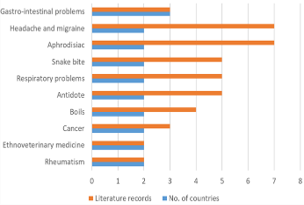Abstract
Maerua triphylla A. Rich. is a shrub or small tree collected from the wild for its edible leaves and also used as traditional medicine. This study is aimed at evaluating the ethnomedicinal and ethnobotanical uses of M. triphylla. Results of the current study are based on data derived from several online databases such as Scopus, Google Scholar, PubMed and Science Direct, and pre-electronic sources such as scientific publications, books, dissertations, book chapters and journal articles. This study revealed that the fruit, leaf, root, stem bark and twig infusion and/or decoction of M. triphylla are mainly used as ethnoveterinary medicine, aphrodisiac and antidote for poisoning, and traditional medicine for rheumatism, boils, cancer, respiratory problems, snakebite, headache, migraine and gastro-intestinal problems. Phytochemical compounds identified from dried aerial parts and branches of M. triphylla include betaines and quaternary ammonium compounds such as 3-hydroxyprolinebetaine, glycine betaine, proline betaine and 3-hydroxy-1,1-dimethyl pyridinium. Preliminary ethnopharmacological research revealed that M. triphylla leaf extracts have acaricidal and cytotoxicity activities. Documentation of the medicinal uses, phytochemistry and pharmacological properties of M. triphylla is important as this information provides baseline data required for future research focusing on ethnopharmacological properties of the species. Maerua triphylla should be subjected to detailed phytochemical, pharmacological and toxicological evaluations aimed at correlating its medicinal uses with its phytochemistry and pharmacological properties.
Full text article
Authors

This work is licensed under a Creative Commons Attribution-NonCommercial-NoDerivatives 4.0 International License.

